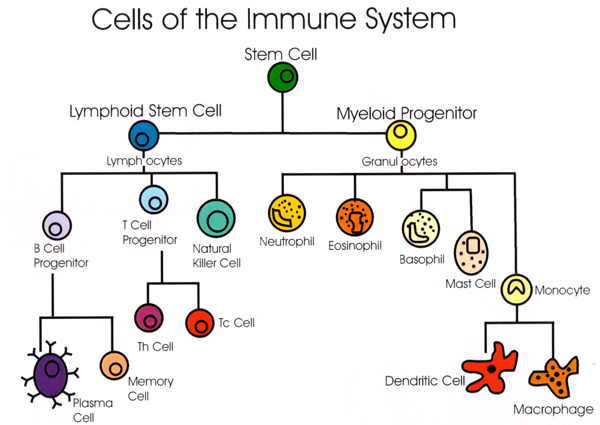Basics of the Immune System
The immune system is probably one of the most complicated systems in your body. It communicates with the rest of your body, and also defends it from bad bacteria. It also attacks bad bacteria with cells like macrophages and neutrophils.
This complicated system involves many different parts, but here are the few that I will be talking about:
Macrophage - Defender
Neutrophils - Attacker
Dendritic Cell - Decision Maker
Helper T Cell - Keeps Other Cells Energized
B Cell - Produces Antibodies
Antibodies - Slows down, immobilizes, and kills bad bacteria

The Process of the Immune System
Say you are cut by a dirty piece of glass. The first barrier of your immune system has been breached. Your skin. Bacteria from the glass then seize the opportunity to flood into the cut. They immediately began to multiply by feeding on your bodies resources.

They swarm unnoticed until they actually began to damage the other cells around them. This is where the macrophages come into play. These large cells guard every part of your body, and most of the time, they can take out a whole infection on their own, swallowing up to 100 bacteria each. They also send out communication proteins so that the body will send out water into the battle so it will make fighting easier. This causes the slight swelling you get after a cut. If the bacteria gets out of control, the macrophages send for backup. Neutrophils leave their patrol in the blood stream to come help. The neutrophils fight so furiously that they actually kill good body cells and themselves in the process. The macrophages then communicate to a different cell, the dendritic cell. These cells are the brain of the immune system. They take samples from the enemy bacteria and decide what the next move should be. When they do decide, they travel to the closest lymph node, which takes them about a day.
Once the dendritic cells reach the lymph node, they search for T helper cells. When they find them, the dendritic cell presents the samples of the bacteria it had collected, and a chemical reaction takes place between both cells. The T helper cells begin to rapidly multiply. Some of them become memory T helper cells, which are kept in the lymph node, so that if you ever have an infection like this again, it will remember how to efficiently take care of it. The second group of T helper cells go help battle with the bacteria. But the third group travels to the center of the lymph node and finds the virgin B cells. And when they do, they connect, and the B cells, no longer virgin, began to multiply. And during this process, the B cells also produce a swarm of a tiny but powerful weapon: antibodies. The B cells work so hard to produce these antibodies that they begin to shut down. But the T helper cells give them energy by stimulating them.
The infection has gotten out of control. The bacteria has kept multiplying, and many of the defense cells have been killed, even though the T helper cells have been trying there hardest to keep the other cells alive. But finally, help arrives. The antibodies invade the bacteria, disabling and killing them. They also attach to the bacteria, immobilizing them, making them an easy target. The microphages then take care of that bacteria. And then, all of the cells that helped in this battle commit suicide, so as not to infect the body with any bacteria that they might have touched.
How to Keep the Immune System Healthy
If it wasn't for our immune system, we would be very sick, unhealthy, and probably dead. So its a good idea to find ways to keep it strong. Here are some preferable ways to do that:
1. Eat plenty of fruits, vegetables and grains
2. Get plenty of exercise
3. Get a sufficient amount of sleep
4. Wash your hands periodically
5. Sustain a healthy weight
6. Don't overdo you intake on alcohol
7. Never smoke